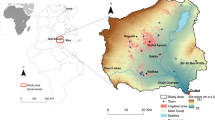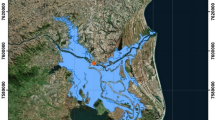Abstract
Irrigated agriculture is an important economic factor in the rural parts of the metropolitan area of Hamburg. It is commonly expected that climate change will reduce the groundwater quantities available for field irrigation. Against this background, the ratio of irrigation need and groundwater recharge (IGR-ratio) is suggested as an indicator to assess climate change impacts on the vulnerability of groundwater resources towards overexploitation by agricultural irrigation. The IGR-ratio has been assessed based on the distributed water balance model mGROWA, i.e. under consideration of the simulated groundwater recharge levels and the field crop-specific irrigation need of the commonly cultivated field crops. The spatial IGR-ratio distribution determined for the observed reference period 1971–2000 has shown that the delineated vulnerable areas coincide with the regions for which high irrigation quantities have been documented at present. Additionally, the IGR-ratio depicts the areas in which irrigation is currently still negligible, but in which the introduction of irrigation into agricultural practice would lead to an immediate overexploitation of the sustainably available groundwater budget. The possible impact of future climate on IGR-ratios was determined by using a model chain of mGROWA and the regional climate models REMO and WETTREG2010. The related ensemble simulations did not provide a uniform tendency of possible future IGR-ratio changes. Whereas the mGROWA–WETTREG2010 realisations projected a very high increase in the IGR-ratios, the mGROWA–REMO realisations did not show a pronounced trend of increasing IGR-ratios. Therefore, considerable uncertainties remain regarding the future bandwidth of IGR-ratio changes.








Similar content being viewed by others

References
Allen RG, Pereira LS, Raes D, Smith M (1998) Crop evapotranspiration—guidelines for computing crop water requirements. FAO - Food and Agriculture Organization, United Nations
Battermann HW, Plumeyer C-H, Theuvsen L (2010) The meaning of field irrigation for the land lease market in northeast Lower Saxony. Berichte Landwirtsch 88:407–409
Becker A, Serban P (1990) Hydrological models for water-resources system design and operation. Operational Hydrology Report No. 34. World Meteorological Organisation, Geneva
Bindi M, Olesen JE (2011) The responses of agriculture in Europe to climate change. Reg Environ Change 11:151–158. doi:10.1007/s10113-010-0173-x
Bogena H, Kunkel R, Schöbel T, Schrey HP, Wendland F (2005) Distributed modeling of groundwater recharge at the macroscale. Ecol Model 187:15–26. doi:10.1016/j.ecolmodel.2005.01.023
Delworth TL, Knutson TR (2000) Simulation of early 20th century global warming. Science 287:2246–2250. doi:10.1126/science.287.5461.2246
Disse M (1995) Modellierung der Verdunstung und der Grundwasserneubildung in ebenen Einzugsgebieten. PhD thesis, Fakultät für Bauingenieur- und Vermessungswesen der Universität Fridericiana zu Karlsruhe (TH), Karlsruhe
Döll P (2002) Impact of climate change and variability on irrigation requirements: a global perspective. Clim Change 54:269–293. doi:10.1023/a:1016124032231
Ehlers L, Herrmann F, Blaschek M, Duttmann R, Wendland F (2016) Sensitivity of mGROWA-simulated groundwater recharge to changes in soil and land use parameters in a Mediterranean environment and conclusions in view of ensemble-based climate impact simulations. Sci Total Environ 543:937–951. doi:10.1016/j.scitotenv.2015.04.122
Elliott J et al (2014) Constraints and potentials of future irrigation water availability on agricultural production under climate change. Proc Natl Acad Sci 111:3239–3244. doi:10.1073/pnas.1222474110
Engel N (2012) Standort- und vegetationsabhängige Beregnungssteuerung mittels eines Bodenwasserhaushaltsmodells (BOWAB). GeoBerichte Landesamt Bergbau Energ Geol 20:99–106
Engel N, Müller U, Schäfer W (2012) BOWAB—Ein Mehrschicht-Bodenwasserhaushaltsmodell. GeoBerichte Landesamt Bergbau Energ Geol 20:85–98
Haberlandt U, Klöcking B, Krysanova V, Becker A (2001) Regionalisation of the base flow index from dynamically simulated flow components—a case study in the Elbe River Basin. J Hydrol 248:35–53. doi:10.1016/S0022-1694(01)00391-2
Herrmann F, Jahnke C, Jenn F, Kunkel R, Voigt H-J, Voigt J, Wendland F (2009) Groundwater recharge rates for regional groundwater modelling: a case study using GROWA in the Lower Rhine lignite mining area, Germany. Hydrogeol J 17:2049–2060. doi:10.1007/s10040-009-0493-4
Herrmann F, Chen S, Heidt L, Elbracht J, Engel N, Kunkel R, Müller U, Röhm H, Vereecken H, Wendland F (2013) Zeitlich und räumlich hochaufgelöste flächendifferenzierte Simulation des Landschaftswasserhaushalts in Niedersachsen mit dem Model mGROWA. Hydrol Wasserbewirtsch 57:206–224. doi:10.5675/HyWa_2013,5_2
Herrmann F, Chen S, Hübsch L, Engel N, Kunkel R, Müller U, Vereecken H, Wendland F (2014) Auswirkung von möglichen Klimaänderungen auf den Bodenwasserhaushalt und die Grundwasserneubildung in der Metropolregion Hamburg. In: Kaden S, Dietrich O, Theobald S (eds) Wassermanagement im Klimawandel - Möglichkeiten und Grenzen von Anpassungsmaßnahmen. oekom verlag, Munich
Herrmann F, Keller L, Kunkel R, Vereecken H, Wendland F (2015) Determination of spatially differentiated water balance components including groundwater recharge on the Federal State level—a case study using the mGROWA model in North Rhine-Westphalia (Germany). J Hydrol Reg Stud 4:294–312. doi:10.1016/j.ejrh.2015.06.018
Iglesias A, Garrote L, Quiroga S, Moneo M (2011) A regional comparison of the effects of climate change on agricultural crops in Europe. Clim Change 112:29–46. doi:10.1007/s10584-011-0338-8
IPCC (2007) Climate change 2007: synthesis report. Contribution of working groups I, II and III to the fourth assessment report of the intergovernmental panel on climate change. In: Core Writing Team, Pachauri RK, Reisinger (eds) IPCC, Geneva
Jacob D, Bülow K, Kotova L, Moseley C, Petersen J, Rechid D Regionale Klimaprojektionen für Europa und Deutschland: Ensemble-Simulationen für die Klimafolgenforschung. Helmholtz-Zentrum Geesthacht, Climate Service Center (CSC). http://www.climate-service-center.de/031409/index_0031409.html.de
Jacob D, Podzun R (1997) Sensitivity studies with the regional climate model REMO. Meteorol Atmos Phys 63:119–129. doi:10.1007/bf01025368
Jacob D et al (2007) An inter-comparison of regional climate models for Europe: model performance in present-day climate. Clim Change 81:31–52. doi:10.1007/s10584-006-9213-4
Jacob D, Göttel H, Kotlarski S, Lorenz P, Sieck K (2008) Klimaauswirkungen und Anpassung in Deutschland - Phase 1: Erstellung regionaler Klimaszenarien für Deutschland vol 11. Umweltbundesamt. http://www.umweltbundesamt.de/sites/default/files/medien/publikation/long/3513.pdf
Jacob D et al (2014) EURO-CORDEX: new high-resolution climate change projections for European impact research. Reg Environ Change 14:563–578. doi:10.1007/s10113-013-0499-2
Jenson SK, Domingue JO (1988) Extracting topographic structure from digital elevation data for geographic information system analysis. Photogramm Eng Remote Sens 54:1593–1600
Jungclaus JH, Keenlyside N, Botzet M, Haak H, Luo JJ, Latif M, Marotzke J, Mikolajewicz U, Roeckner E (2006) Ocean circulation and tropical variability in the coupled model ECHAM5/MPI-OM. J Clim 19:3952–3972. doi:10.1175/jcli3827.1
Kellner U, Mußhoff O, Battermann HW (2012) The economic valuation of irrigation under consideration of risk and changes in water withdrawal permits. Ger J Agric Econ 61(1):1–12
Koster EA (2005) The physical geography of Western Europe. In: Koster EA (ed)[E-Book] The Oxford regional environments series
Kotlarski S, Block A, Böhm U, Jacob D, Keuler K, Knoche R, Rechid D, Walter A (2005) Regional climate model simulations as input for hydrological applications: evaluation of uncertainties. Adv Geosci 5:119–125. doi:10.5194/adgeo-5-119-2005
Kowalewski J, Schulze S (2010) Die Struktur der Landwirtschaft in der Metropolregion Hamburg. Hamburgisches WeltWirtschaftsInstitut (HWWI), Hamburg. http://www.hwwi.org/fileadmin/_migrated/tx_wilpubdb/HWWI_Research_Paper_1-33_01.pdf
Kreienkamp F, Spekat A, Enke W (2010) Weiterentwicklung von WETTREG bezüglich neuartiger Wetterlagen. Climate & Environment Consulting Potsdam GmbH, Potsdam
Kreins P, Henseler M, Anter J, Herrmann F, Wendland F (2015) Quantification of climate change impact on regional agricultural irrigation and groundwater demand. Water Resour Manag 29:3585–3600. doi:10.1007/s11269-015-1017-8
Kunkel R, Wendland F (2002) The GROWA98 model for water balance analysis in large river basins—the river Elbe case study. J Hydrol 259:152–162. doi:10.1016/S0022-1694(01)00579-0
Kunkel R, Bogena H, Tetzlaff B, Wendland F (2006) Digitale Grundwasserneubildungskarte von Niedersachsen, Nordrhein-Westfalen, Hamburg und Bremen: erstellung und Auswertungsbeispiele. Hydrol Wasserbewirtsch 50:212–219
Kunkel R, Wendland F, Röhm H, Elbracht J (2012) Das CLINT-Interpolationsmodell zur Regionalisierung von Klimadaten und WETTREG-Klimaprojektionen für Analysen zum regionalen Boden- und Grundwasserhaushalt in Niedersachsen und Bremen. GeoBerichte Landesamt Bergbau Energ Geol 20:6–31
Lane ME, Kirshen PH, Vogel RM (1999) Indicators of impacts of global climate change on U.S. water resources. J Water Resour Plan Manag 125:194–204. doi:10.1061/(asce)0733-9496(1999)125:4(194)
Marke T, Mauser W, Pfeiffer A, Zängl G (2011) A pragmatic approach for the downscaling and bias correction of regional climate simulations: evaluation in hydrological modeling. Geosci Model Dev 4:759–770
Monteith JL (1965) Evaporation and environment. In: Fogg GE (ed) Symposium of the society for experimental biology, the state and movement of water in living organisms, pp 205–234
Moriasi DN, Arnold JG, Liew MWV, Bingner RL, Harmel RD, Veith TL (2007) Model evaluation guidelines for systematic quantification of accuracy in watershed simulations. Trans ASABE 50:885–900. doi:10.13031/2013.23153
Moriondo M, Bindi M, Kundzewicz ZW, Szwed M, Chorynski A, Matczak P, Radziejewski M, McEvoy D, Wreford A (2010) Impact and adaptation opportunities for European agriculture in response to climatic change and variability. Mitig Adapt Strateg Glob Change 15:657–679. doi:10.1007/s11027-010-9219-0
Müller U, Waldeck A (2011) Auswertungsmethoden im Bodenschutz, vol 19. GeoBerichte. Landesamt für Bergbau, Energie und Geologie, Niedersachsen
Panagopoulos A, Arampatzis G, Tziritis E, Pisinaras V, Herrmann F, Kunkel R, Wendland F (2014) Assessment of climate change impact in the hydrological regime of River Pinios Basin, central Greece. Desalin Water Treat. doi:10.1080/19443994.2014.984926
Petry U, Dietrich J, Förster K, Wallner M, Berndt C, Meon G, Haberlandt U (2015) Ein Ansatz zur Validierung von Klimamodelldaten als Basis für die Interpretation von wasserwirtschaftlichen Klimafolgenabschätzungen in Niedersachsen. Hydrol Wasserbewirtsch 59:155–173. doi:10.5675/HyWa_2015,4_3
Pfeifer S, Bülow K, Gobiet A, Hänsler A, Mudelsee M, Otto J, Rechid D, Teichmann C, Jacob D (2015) Robustness of ensemble climate projections analyzed with climate signal maps: seasonal and extreme precipitation for Germany. Atmosphere 6:677–698. doi:10.3390/atmos6050677
Renger M, Strebel O (1982) Beregnungsbedürftigkeit der landwirtschaftlichen Nutzflächen in Niedersachsen. Geologisches Jahrb Reihe F 13:3–66
Riediger J, Breckling B, Svoboda N, Schröder W (2016) Modelling regional variability of irrigation requirements due to climate change in Northern Germany. Sci Total Environ 541:329–340. doi:10.1016/j.scitotenv.2015.09.043
Roeckner E et al (2003) The atmospheric general circulation model ECHAM 5. PART I: model description vol 349. Max-Planck-Institut für Meteorologie. https://www.mpimet.mpg.de/fileadmin/publikationen/Reports/max_scirep_349.pdf
Schlünzen KH, Hoffmann P, Rosenhagen G, Riecke W (2010) Long-term changes and regional differences in temperature and precipitation in the metropolitan area of Hamburg. Int J Climatol 30:1121–1136. doi:10.1002/joc.1968
Schoetter R, Hoffmann P, Rechid D, Schlünzen KH (2012) Evaluation and bias correction of regional climate model results using model evaluation measures. J Appl Meteorol Climatol 51:1670–1684. doi:10.1175/jamc-d-11-0161.1
Spekat A, Kreienkamp F, Enke W (2010) An impact-oriented classification method for atmospheric patterns. Phys Chem Earth Parts A/B/C 35:352–359. doi:10.1016/j.pce.2010.03.042
Statistische Ämter des Bundes und der Länder (2011) Agrarstrukturen in Deutschland Einheit in Vielfalt - Regionale Ergebnisse der Landwirtschaftszählung 2010. http://www.statistikportal.de/Statistik-Portal/landwirtschaftszaehlung_2010.pdf
Tetzlaff B, Kuhr P, Wendland F (2008) Ein neues Verfahren zur differenzierten Ableitung von Dränflächenkarten für den mittleren Maßstabsbereich auf Basis von Luftbildern und Geodaten. Hydrol Wasserbewirtsch 52:9–18
Tetzlaff B, Kuhr P, Vereecken H, Wendland F (2009a) Aerial photograph-based delineation of artificially drained areas as a basis for water balance and phosphorus modelling in large river basins. Phys Chem Earth Parts A/B/C 34:552–564. doi:10.1016/j.pce.2009.02.002
Tetzlaff B, Kuhr P, Wendland F (2009b) A new method for creating maps of artificially drained areas in large river basins based on aerial photographs and geodata. Irrig Drain 58:569–585. doi:10.1002/ird.426
Tetzlaff B, Andjelov M, Kuhr P, Uhan J, Wendland F (2015) Model-based assessment of groundwater recharge in Slovenia. Environ Earth Sci 74:6177–6192. doi:10.1007/s12665-015-4639-5
Wada Y et al (2013) Multimodel projections and uncertainties of irrigation water demand under climate change. Geophys Res Lett 40:4626–4632. doi:10.1002/grl.50686
Wegehenkel M, Heinrich U, Jochheim H, Kersebaum KC, Röber B (2010) Evaluation of three different regional climate change scenarios for the application of a water balance model in a mesoscale catchment in Northeast Germany. Adv Geosci 27:57–64. doi:10.5194/adgeo-27-57-2010
Wendland F, Kunkel R, Tetzlaff B, Dörhöfer G (2003) GIS-based determination of the mean long-term groundwater recharge in Lower Saxony. Environ Geol 45:273–278. doi:10.1007/s00254-003-0879-x
Wittenberg H (2015) Groundwater abstraction for irrigation and its impacts on low flows in a watershed in Northwest Germany. Resources 4:566–576. doi:10.3390/resources4030566
Acknowledgments
This study has been carried out in the framework of the funding programme KLIMZUG-NORD “Strategies adapted to climate changes concerning the metropolitan area of Hamburg” on behalf of the Federal Ministry of Education and Research (BMBF).
Author information
Authors and Affiliations
Corresponding author
Additional information
This article is part of a Topical Collection in Environmental Earth Sciences on “Water in Germany”, guest edited by Daniel Karthe, Peter Chifflard, Bernd Cyffka, Lucas Menzel, Heribert Nacken, Uta Raeder, Mario Sommerhäuser and Markus Weiler.
Rights and permissions
About this article
Cite this article
Herrmann, F., Kunkel, R., Ostermann, U. et al. Projected impact of climate change on irrigation needs and groundwater resources in the metropolitan area of Hamburg (Germany). Environ Earth Sci 75, 1104 (2016). https://doi.org/10.1007/s12665-016-5904-y
Received:
Accepted:
Published:
DOI: https://doi.org/10.1007/s12665-016-5904-y



